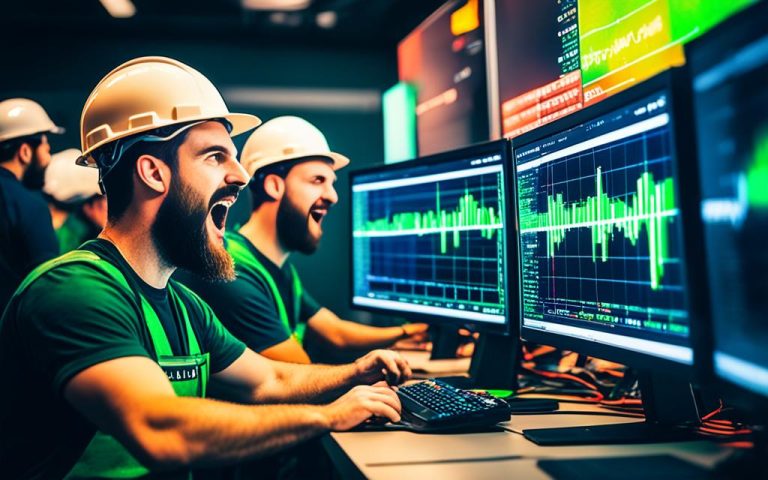In cryptocurrency trading, a crypto signal is a key tool. It guides traders on when to buy or sell. These signals are like tips. They point out possible profitable market moves using analysis and trends.
Crypto signals come from two places. One is expert traders who do their own research. The other is algorithms. These algorithms look at many signs in the market. Both methods aim to help traders pick the best opportunities.
Reliable crypto signals are important for successful trading. When you look at where signals come from, check the signal provider’s trustworthiness. See how clear they are in their process. Also, look at how accurate their signals have been over time.
Sources like Token Metrics are known for their trustworthy insights. They use AI and data analysis. This can help traders navigate the unpredictable cryptocurrency market wisely.
Understanding Crypto Signals and Their Components
Crypto signals are trading advice for buying or selling cryptocurrency. They are often given by skilled traders or using automated tools. These signals are very helpful in the ever-changing crypto market. Now, let’s explore what crypto signals really are, why they matter, where they come from, and what makes them up.
Crypto Signal Definition:
A crypto signal tells you the best time to buy or sell a specific cryptocurrency. These tips help traders see the market’s current state, making their decisions more educated.
Purpose of Crypto Signals:
The main goal of crypto signals is to help traders make more money while keeping risks low. They show when to buy or sell, what prices to look for, and when to exit a trade. This helps traders use expert advice to their advantage.
Origin of Crypto Signals:
The need for help in the unpredictable world of cryptocurrencies made crypto signals popular. Traders are always looking for ways to get ahead using expert information. Thus, crypto signals have become a vital tool for traders.
Key Components of Crypto Signals:
Understanding what makes up a crypto signal is important. They typically include:
- Asset Name: This tells you which cryptocurrency to trade, making the recommendation clear.
- Buy/Sell Indication: Clearly says whether to buy or sell the asset.
- Price Point: The price level suggested for buying or selling.
- Stop Loss Level: A price level to exit a trade and prevent big losses.
- Take Profit Level: The price level where it’s good to close a trade and secure profit.
Considering these components helps traders act on good advice. It can improve their trading game by a lot.
Benefits and Risks of Crypto Signals
Crypto signals help traders handle the up-and-down world of cryptocurrency. They give timely advice, which lets investors catch good deals and make smart choices. For those just starting, crypto signals can simplify confusing market trends and offer a clear path.
Advanced traders use these signals too, enhancing their strategies. They get ahead in their trades by using these valuable tools.
Crypto signals can work automatically. This means they look at set rules and data to give insights fast. Platforms like Token Metrics use advanced AI for these signals.
Yet, not all signals are perfectly accurate. The crypto market’s constant movement makes getting exact outcomes tough. It’s up to each trader to do their homework and keep up with market news. Understanding your own risks is crucial for success.
Relying only on automated signals can be risky. They might miss real-world events that change the market. Also, some may try to trick traders with false signals to boost their own profits.
That’s why being careful and doing your own research is key. This ensures the signals you follow are legit and can actually help you make good choices.
Some crypto signals are free, and some you pay for. It’s important to check if free signals are as good as the paid ones. Many traders look for “verified” signal providers for trust and reliability. Such providers go through a strict process, showing they are transparent and have a good track record.
Crypto signal providers offer a wide range of strategies and assets, fitting different trader goals. They often include ways to manage risks, which is essential during market ups and downs. Plus, many signal providers give resources and advice to help improve traders’ understanding of the market.
But traders shouldn’t rely too heavily on these signals. Depending too much on them can stop you from developing your own strategy. It can also get expensive with subscription fees. Always weigh the costs against the potential benefits of using these services. Also, be careful about sharing personal and financial info online. Good security practices are a must when interacting with signal providers.
Types of Crypto Signals
Different crypto signals give different kinds of important information. These include:
| Signal Type | Description |
|---|---|
| Technical Analysis Signals | They look at past market trends, like price and volume movements, using tools such as moving averages and Bollinger Bands. |
| Fundamental Analysis Signals | They judge cryptocurrency projects based on their tech, partnerships, and public reaction, among others. |
| Sentiment Analysis Signals | These signals look at how people feel about certain cryptos by checking social media and forums. |
| Algorithmic Signals | These are signals made by computer programs that study lots of market data. They use math and even learn from past trades. |
Risks and Risk Management
Using crypto signals requires smart risk management to cut down losses and seize opportunities. This means setting up stop-loss orders, not putting all your eggs in one basket, and being careful with how much risk you take on.
Testing signals in the past can also be a smart move. It shows how well the signals have performed under different conditions. This can help in making better trading decisions today.
Find out more about Token Metrics.
Conclusion
Crypto trading signals help traders and investors in the cryptocurrency market. They empower people to make smart decisions. This can lead to more profits. It’s important, though, not to depend only on these signals.
Signals suggest when to buy or sell. But, it’s crucial to also do your own work. This includes keeping up with market trends and understanding how much risk you’re comfortable with. This extra effort ensures a well-rounded trading strategy.
It’s key to pick reliable signal providers. Look to top platforms like CryptoHopper, Signal Profits, and TradingView. They offer quality signals. When used with your own research, they can boost your success.
Manage your risks well and don’t rely too much on signals. This helps you face the ups and downs of the crypto market. Always make choices based on solid information for a better trading experience.
FAQ
What is a crypto signal?
A crypto signal tells someone if they should buy or sell a certain cryptocurrency. It also says when and at what price to do this.
Where do crypto signals come from?
Experts might research and give out these signals. Or, it might be a computer that looks at different signs and decides.
What are the key components of a crypto signal?
A crypto signal has the name of the cryptocurrency and says if you should buy or sell it. It also mentions the price, the loss you should stop at, and the profit you aim for.
What are the benefits of crypto signals?
These signals help traders know what to do at the right time. For new people, they explain how the market works. For advanced traders, they improve strategies and manage risks well.
They give the chance to earn more and lose less in trading.
Are crypto signals 100% accurate?
No, they’re not perfect because markets can change fast. It’s still important to do your own checking and keep up with market updates.
How can traders identify reliable crypto signals?
To find trustworthy signals, check who’s giving them. See if they are open about how they decide. Also, look at how often they are right. Using sources like Token Metrics that use AI and data can be smart.



















